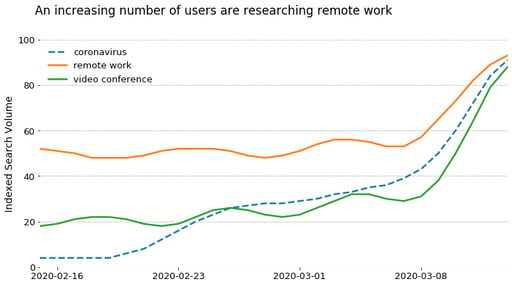How the COVID-19 Pandemic is Changing the Way We Work

The global coronavirus will have a monumental impact on the workplace of tomorrow as it forces employers and employees to re-evaluate their pre-COVID-19 work life.
As the coronavirus disrupts economies throughout the world, employers and employees must adapt to quarantine and lockdown and be prepared for one of the worst global recessions since the Great Depression. Not only will these workplace challenges affect employees today, but they’ll also have a monumental impact on the workforce of tomorrow.
Organizations that have adapted well to the COVID-19 working environment are embracing remote working, giving employees more flexibility, and finding ways to become more resilient in the face of major disruptions. Major companies have also prioritized worker health and well-being. Below, we’ll explore these changing work trends in further detail and show you how the global coronavirus is forcing business leaders and employees to reconsider their existing work practices and office life.
Work Practices Pre-COVID-19
Prior to the coronavirus pandemic, HR and business leaders embraced new changes, technologies, and ideas fairly slowly. There wasn’t a need to adjust to changing circumstances as quickly as there is now. Gradual, incremental innovation was seen as the best way to shift from traditional to modernized work practices.
Working Practices During COVID-19
As the pandemic hit, extreme disruptions led to major changes to most organizations. Businesses had to explore different business models, take care of their now remotely working employees, reduce costs where possible, and shift to a digital working environment. The organizations that have been able to adapt are seeing many advantages from their new work practices, which has many employers questioning the pre-COVID work environment.
“The coronavirus crisis is forcing white-collar America to reconsider nearly every aspect of office life,” writes Clive Thompson, a New York Times reporter. “Some practices now seem to be wastes of time, happily discarded; others seem to be unexpectedly crucial, and impossible to replicate online. For workers wondering right now if they’re ever going back to the office, the most honest answer is this: Even if they do, the office might never be the same.”
The office environment post-COVID-19 will have many significant changes. For example, many employees that have greater flexibility are keen to retain these benefits. Businesses that reap the benefits of new strategies will continue to use parts of these strategies in the post-COVID-19 world. Here are a few examples of some of these new-age working practices and why they’re here to stay even after the pandemic:
Remote Working
While many companies were open to exploring the idea of working from home as a way to attract and retain talent, employers were concerned about their ability to effectively collaborate digitally.

While many managers feared lower levels of productivity, this simply hasn’t proven true. In some cases, such as with the consulting firm Accenture, productivity levels increased.
This is supported by an experiment in 2012 by the US Patent & Trademark Office that found that when employees work remotely, their productivity levels increase by 4.4%. A study from Stanford in 2015 also found that when one Chinese travel agency assigned a random group of employees to work remotely for 9 months, productivity increased by 13% and resulted in an increase of $2,000 in annual profits per employee.
With the barriers to remote working dissolving and the benefits becoming more obvious, many companies will allow their employees to continue to work from home post-pandemic. An example is Twitter, where CEO Jack Dorsey announced that the company will support employees who wish to work from home indefinitely.
Prioritizing Employee Health
While the coronavirus pandemic has led to major unemployment, many businesses recognized that it’s a great opportunity to show employees how much they care. Many businesses went the extra mile for their employees, providing additional health and wellness support. Such support includes enhanced healthcare  benefits, broader wellness programs, and additional paid time off or vacation programs. CoreHealth’s well-being technology makes it simple and easy for employers to select the programs that matter most to their employees.
benefits, broader wellness programs, and additional paid time off or vacation programs. CoreHealth’s well-being technology makes it simple and easy for employers to select the programs that matter most to their employees.
By expanding the employer’s social safety role, forward-thinking companies prioritizing employee health will become the new standard for other organizations looking to enhance the employee experience. These companies will lead in terms of employer branding and will have a competitive advantage in acquiring and retaining top talent in the post-COVID-19 business world.
The global coronavirus has changed the way we view work. Remote working, once seen as a productivity inhibitor, is now recognized as a productivity enabler. Companies will increasingly recognize the importance of creating efficient yet resilient systems, and will likely have an increasingly mixed workforce consisting of employees and contingent workers in the future.
About CoreHealth Technologies
CoreHealth Technologies Inc. is a total well-being technology company trusted by global providers to power their health and wellness programs. Our wellness portals help maximize health, engagement and productivity for 3+ million employees worldwide. We believe people are the driving force of organizations and supporting them to make behavior changes to improve employee health is in everyone’s best interest. With the most flexibility, customizations and integrations of any software in its class, CoreHealth’s all-in-one wellness platform helps grow great wellness companies. Simple to sophisticated, based on you. For more information, visit the CoreHealth website or YouTube Channel.
About The Author
Your Friends in Health at CoreHealth
CoreHealth by Carebook's Health and Wellness Team works hard to bring our readers informative and research validate health and well-being blog articles and resources that support your workplace wellness culture and wellness technology purchase decision.


